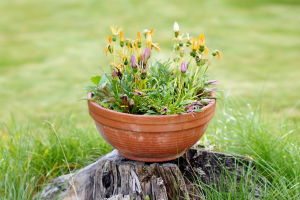The Round-lobed Hepatica (Hepatica americana), a native plant of North America, is a perennial herb that belongs to the buttercup family, Ranunculaceae.
This delicate wildflower can be found in deciduous forests, thriving in shaded, moist environments.
Its early spring bloom marks one of the first signs of life after winter, often appearing before the trees fully leaf out. With its simple yet striking appearance, the Round-lobed Hepatica is a welcome sight for nature lovers and botanists alike. The plant's name comes from its distinctively shaped leaves, usually round to kidney-shaped with deep lobes.
These leaves emerge after the flowers have bloomed and remain throughout the growing season, turning a rich green as the plant matures. In some cases, the leaves may even have a reddish or purplish tint, especially near the base, adding to the plant's visual appeal. These leaves serve as a reminder of the plant's ability to survive and thrive in various conditions, enduring through both winter and the harsh spring rains.
The flowers of the Round-lobed Hepatica are one of its most charming features. They are typically 1 to 2 inches in diameter and appear in white, purple, or pink shades. The flowers have a waxy, almost translucent quality, and the petals are often slightly cupped, giving the flower a star-like appearance.
The central part of the flower contains numerous yellow stamens, creating a contrast that makes the blooms stand out even more against their surrounding foliage. These flowers are not just a visual treat; they play an essential role in the plant's reproduction, attracting pollinators such as bees and butterflies, which are drawn to their nectar.
The Round-lobed Hepatica is well-suited to its woodland habitat, where it thrives in the rich, well-drained soils typical of deciduous forests. It requires a balance of shade and moisture to grow well, making it an ideal plant for shaded garden beds or natural woodland settings.
In the wild, it is commonly found near streams, at the base of hills, or on the forest floor, where it benefits from the dappled sunlight that filters through the canopy above. This preference for moist, shady environments explains why it is often one of the first plants to appear after winter, making it an important part of the forest's early spring ecosystem.
Caring for the Round-lobed Hepatica in a garden setting can be a rewarding experience, but it requires attention to its specific needs. It prefers soil that is rich in organic matter and well-draining, and it benefits from consistent moisture. While it can tolerate some drought, its growth is best when the soil remains moist but not waterlogged.
In areas where the winters are harsh, the plant may die back to the ground, but it will re-emerge in the spring with new growth, ready to bloom once again. One interesting feature of the Round-lobed Hepatica is its ability to tolerate cold temperatures. As an early spring bloomer, it often emerges before the danger of frost has passed, and its flowers are capable of surviving the cold, making it a hardy and resilient plant.
This adaptation is likely a result of the plant's evolutionary history, which has shaped it to thrive in the temperate woodlands of North America.
Despite its beauty and ecological importance, the Round-lobed Hepatica is not widely cultivated outside of its native habitat. It is a plant that requires specific growing conditions, making it a bit more challenging to grow in other areas.
Its early spring blooms, heart-shaped leaves, and resilience to the elements make it a cherished part of the woodland ecosystem.
Whether admired in the wild or carefully cultivated in a garden, this plant continues to captivate those who appreciate the quiet beauty of nature and the cycles of life that unfold each year!


